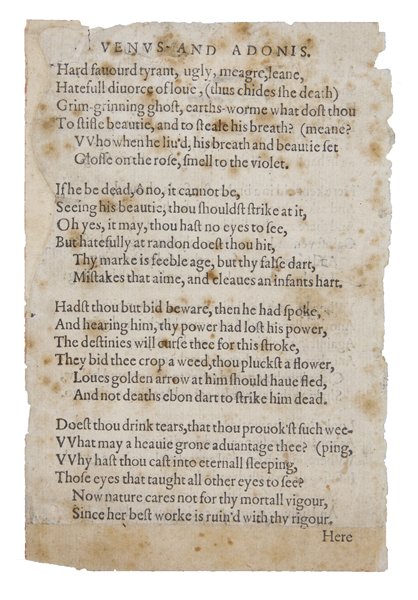This month I want to look at a rare piece in our early printed books collection: a single page (or leaf) from Shakespeare’s first published work Venus and Adonis, written between 1592-3 and entered into the Stationers Register (the English government pre-publication registry) in April, 1593.
Many people may be surprised to learn that in Shakespeare’s lifetime his first and most popular published work was not a play, but rather a minor epic poem inspired by the Roman poet Ovid. Minor epics were well known in the 1590s and typically combined elements of mythology, eroticism, and wit. The tendency to model works after Ovid was also common in the 1590s due to Ovid’s previous inclusion in grammar school curriculum, an education Shakespeare benefited from in Stratford-upon-Avon. The Story of Venus and Adonis comes from Book 10 of Ovid’s Metamorphoses, where Venus, the goddess of love, falls deeply for the human Adonis, a young hunter who accidentally dies after being attacked by a wild boar. In Ovid’s version of the tale, Adonis is the willing lover to Venus, however, in Shakespeare’s ironic and comic interpretation, Adonis does not repay Venus’ admiration and despite his resistance she still attempts to court the young man for physical intimacy. Our leaf, purchased for the Trust in 1864, contains lines 907-954 of Shakespeare’s poem, the moment where Venus sees the boar’s mouth covered in blood and wonders if Adonis is dead.
Venus and Adonis is certainly one of Shakespeare’s more sensual works but was not intended as such in Elizabethan society; rather its dedication to the Earl of Southampton—an educated and sophisticated supporter of the arts—indicates that the work was an attempt at a fashionable exercise in delicate eroticism, skillfully constructed in a classical manner. The poem's popularity throughout the late sixteenth and mid seventeenth century confirms that, by the year 1640, it had already gone through 16 editions. Richard Fields, a supposed friend of Shakespeare who grew up in Stratford-upon-Avon, printed the first edition of the poem in 1593 in quarto format. Today, only one copy of this edition is known to exist and is held at Oxford's Bodleian Library. Fields also printed the second quarto edition of the poem in 1594, as well as the third and fourth octavos editions. The Trust’s leaf was once part of a rare second quarto edition of 1594.
Venus and Adonis also explores themes such as the close connection between love and pain, the powerful effects of passion and the relationship between the immortal and mortal, human and mythology. Although some consider Venus and Adonis to be an immature failure, other critics believe it to be an important piece of work in Shakespeare’s early canon, comparing it closely with plays such as Romeo and Juliet, Love’s Labour’s Lost, and A Midsummer Night’s Dream.


For additional reading, see Shakespeare's Poems
